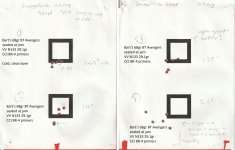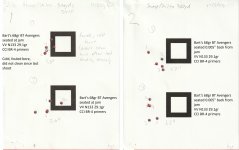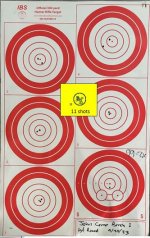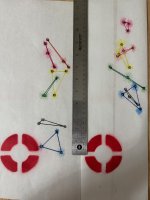Hi All,
I trying out a new bullet in my Savage target rifle and am getting the best groups from a cold bore, which I’ve never seen before in any rifle. Usually, the cold bore shot is off a little and then the rifle settles down, but with Bart Avenger 68gr boat-tail bullets, the opposite is happening. The rifle is a Savage Target action with a 26" Shilen stainless select match bull barrel (0 freebore, 14” twist, ratchet groove) in 6BR Norma. I’m using a load that worked well for Bart’s 68 gr Ultra FB and Berger 68gr FB Target. The load was: Lapua cases (annealed), VV N133 29.1gr, CCI BR-4 primers, with bullet seated at jam or 0.005” back from jam.
All the shooting was done at 300 yards with very light wind and a temperature of around 34 F. All the groups were five shots. On the first day (please see Target 1), the first group from a clean, cold bore was around 0.6” ctc, which made me happy. Then the groups started to open up. I didn’t make much of this behavior until it happened again the next time I shot this rifle a few days later under similar conditions. The first group from a cold, fouled bore was about 1.0” ctc (please see Target 2), and then the groups started opening up. I didn’t the clean the bore before the second session since I only had 20 shots after the last cleaning and was curious to see how the rifle shot these bullets with the bore already fouled. On the second day, the bullets were at jam for the first two groups and 0.005” ack from the jam for the last two groups.
I’m wondering if the barrel is expanding slightly when warm, making the bullet fit a bit looser and causing accuracy to drop? Or maybe, the powder/cases warm up a bit in the pre-heated chamber, causing a slightly higher MV, which brings the rifle out of tune? I doubt this is the case since I’ve never seen that much sensitivity to MV in this rifle, but I’m running out of ideas. The only thing I can think of is to try some other powder weights at 300 yards.
If you have seen this before and/or have any ideas what is going on and how to fix it, please let me know.
Thanks,
John
I trying out a new bullet in my Savage target rifle and am getting the best groups from a cold bore, which I’ve never seen before in any rifle. Usually, the cold bore shot is off a little and then the rifle settles down, but with Bart Avenger 68gr boat-tail bullets, the opposite is happening. The rifle is a Savage Target action with a 26" Shilen stainless select match bull barrel (0 freebore, 14” twist, ratchet groove) in 6BR Norma. I’m using a load that worked well for Bart’s 68 gr Ultra FB and Berger 68gr FB Target. The load was: Lapua cases (annealed), VV N133 29.1gr, CCI BR-4 primers, with bullet seated at jam or 0.005” back from jam.
All the shooting was done at 300 yards with very light wind and a temperature of around 34 F. All the groups were five shots. On the first day (please see Target 1), the first group from a clean, cold bore was around 0.6” ctc, which made me happy. Then the groups started to open up. I didn’t make much of this behavior until it happened again the next time I shot this rifle a few days later under similar conditions. The first group from a cold, fouled bore was about 1.0” ctc (please see Target 2), and then the groups started opening up. I didn’t the clean the bore before the second session since I only had 20 shots after the last cleaning and was curious to see how the rifle shot these bullets with the bore already fouled. On the second day, the bullets were at jam for the first two groups and 0.005” ack from the jam for the last two groups.
I’m wondering if the barrel is expanding slightly when warm, making the bullet fit a bit looser and causing accuracy to drop? Or maybe, the powder/cases warm up a bit in the pre-heated chamber, causing a slightly higher MV, which brings the rifle out of tune? I doubt this is the case since I’ve never seen that much sensitivity to MV in this rifle, but I’m running out of ideas. The only thing I can think of is to try some other powder weights at 300 yards.
If you have seen this before and/or have any ideas what is going on and how to fix it, please let me know.
Thanks,
John




